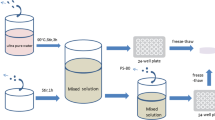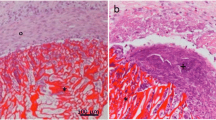Abstract
This study aims to pre-assess the in vitro and in vivo biocompatibility of poly(vinyl alcohol)-carboxylmethyl-chitosan-poly(ethylene glycol) (PCP) scaffold. PCP was lyophilised to create supermacroporous structures. 3-(4, 5-dimethyl-thiazol-2yl)-2, 5-diphenyltetrazolium bromide (MTT) assay and immunohistochemistry (IHC) were used to evaluate the effectiveness of PCP scaffolds for chondrocytes attachment and proliferation. The ultrastructural was assessed using scanning electron microscopy (SEM) and transmission electron microscopy (TEM). Extracellular matrix (ECM) formation was evaluated using collagen type-II staining, glycosaminoglycan (GAG) and collagen assays. Histological analysis was conducted on 3-week implanted Sprague–Dawley rats. The MTT, IHC, SEM and TEM analyses confirm that PCP scaffolds promoted cell attachment and proliferation in vitro. The chondrocyte-PCP constructs secreted GAG and collagen type-II, both increased significantly from day-14 to day-28 (P < 0.05). PCP scaffolds did not elicit any adverse effects on the host tissue, but were partially degraded. These results suggest that supermacroporous PCP is a biocompatible scaffold for clinical applications.








Similar content being viewed by others
References
Blunt L, Bills P, Jiang X, Hardaker C, Chakrabarty G. The role of tribology and metrology in the latest development of bio-materials. Wear. 2009;266:424–31.
Hoseini M, Jedenmalm A, Boldizar A. Tribological investigation of coatings for artificial joints. Wear. 2008;264:958–66.
Vinatier C, Bouffi C, Merceron C, Gordeladze J, Brondello JM, Jorgensen C, Weiss P, Guicheux J, Noel D. Cartilage tissue engineering: towards a biomaterial-assisted mesenchymal stem cell therapy. Curr Stem Cell Res Ther. 2009;4:318–29.
Dhandayuthapani B, Yoshida Y, Maekawa T, Kumar D. Polymeric scaffolds in tissue engineering application: a review. Int J Polym Sci. 2011;. doi:10.1155/2011/290602.
Chen FH, Rousche KT, Tuan RS. Technology Insight: adult stem cells in cartilage regeneration and tissue engineering. Nat Clin Pract Rheumatol. 2006;2:373–82.
Sabir M, Xu X, Li L. A review on biodegradable polymeric materials for bone tissue engineering applications. J Mater Sci. 2009;44:5713–24.
Felinto MCFC, Parra DF, Da Silva CC, Angerami J, Oliveira MJA, Lugão AB. The swelling behavior of chitosan hydrogels membranes obtained by UV- and γ-radiation. Nucl Instrum Method B. 2007;265:418–24.
Stammen JA, Williams S, Ku DN, Guldberg RE. Mechanical properties of a novel PVA hydrogel in shear and unconfined compression. Biomaterials. 2001;22:799–806.
Oka M, Ushio K, Kumar P, Ikeuchi K, Hyon SH, Nakamura T, Fujita H. Development of artificial articular cartilage. Proc Inst Mech Eng H. 2000;214:59–68.
Chuang WY, Young TH, Yao CH, Chiu WY. Properties of the poly(vinyl alcohol)/chitosan blend and its effect on the culture of fibroblast in vitro. Biomaterials. 1999;20:1479–87.
Zhuang PY, Li YL, Fan L, Lin J, Hu QL. Modification of chitosan membrane with poly(vinyl alcohol) and biocompatibility evaluation. Int J Biol Macromol. 2012;50:658–63.
Prego C, Torres D, Fernandez-Megia E, Novoa-Carballal R, Quinoa E, Alonso MJ. Chitosan-PEG nanocapsules as new carriers for oral peptide delivery. Effect of chitosan pegylation degree. J Controlled Release. 2006;111:299–308.
Lee SY, Pereira BP, Yusof N, Selvaratnam L, Yu Z, Abbas AA, Kamarul T. Unconfined compression properties of a porous poly(vinyl alcohol)-chitosan-based hydrogel after hydration. Acta Biomater. 2009;5:1919–25.
Vinsova J, Vavrikova E. Recent advances in drugs and prodrugs design of chitosan. Curr Pharm Des. 2008;14:1311–26.
Vunjak-Novakovic G, Radisic M. Cell seeding of polymer scaffolds. Methods Mol Biol. 2004;238:131–46.
Yamamoto M, Tabata Y. Tissue engineering by modulated gene delivery. Adv Drug Deliv Rev. 2006;58:535–54.
Doherty GJ, McMahon HT. Mediation, modulation, and consequences of membrane-cytoskeleton interactions. Annu Rev Biophys. 2008;37:65–95.
Chen G, Ushida T, Tateishi T. Preparation of poly(l-lactic acid) and poly(dl-lactic-co-glycolic acid) foams by use of ice microparticulates. Biomaterials. 2001;22:2563–7.
Harris LD, Kim BS, Mooney DJ. Open pore biodegradable matrices formed with gas foaming. J Biomed Mater Res. 1998;42:396–402.
Yadav PR. Histology. India: Discovery Publishing House Pvt. Ltd.; 2003.
Watt FM. Effect of seeding density on stability of the differentiated phenotype of pig articular chondrocytes in culture. J Cell Sci. 1988;89(Pt 3):373–8.
Stokes DG, Liu G, Dharmavaram R, Hawkins D, Piera-Velazquez S, Jimenez SA. Regulation of type-II collagen gene expression during human chondrocyte de-differentiation and recovery of chondrocyte-specific phenotype in culture involves Sry-type high-mobility-group box (SOX) transcription factors. Biochem J. 2001;360:461–70.
Pizzo AM, Kokini K, Vaughn LC, Waisner BZ, Voytik-Harbin SL. Extracellular matrix (ECM) microstructural composition regulates local cell-ECM biomechanics and fundamental fibroblast behavior: a multidimensional perspective. J Appl Physiol. 2005;98:1909–21.
Kisiday JD, Jin M, DiMicco MA, Kurz B, Grodzinsky AJ. Effects of dynamic compressive loading on chondrocyte biosynthesis in self-assembling peptide scaffolds. J Biomech. 2004;37:595–604.
Martins AM, Kretlow JD, Costa-Pinto AR, Malafaya PB, Fernandes EM, Neves NM, Alves CM, Mikos AG, Kasper FK, Reis RL. Gradual pore formation in natural origin scaffolds throughout subcutaneous implantation. J Biomed Mater Res A. 2012;100:599–612.
Lee BN, da Kim Y, Kang HJ, Kwon JS, Park YH, Chun HJ, Kim JH, Lee HB, Min BH, Kim MS. In vivo biofunctionality comparison of different topographic PLLA scaffolds. J Biomed Mater Res A. 2012;100:1751–60.
Henry JA, Burugapalli K, Neuenschwander P, Pandit A. Structural variants of biodegradable polyesterurethane in vivo evoke a cellular and angiogenic response that is dictated by architecture. Acta Biomater. 2009;5:29–42.
Park SJ, Kim MS, Yu SM, Gu BK, Kim JI, Kim CH. Cellular and soft tissue compatibility to high interconnectivity between pores of chitosan scaffold. Macromol Res. 2012;20:397–401.
Acknowledgments
This study was funded by Science Fund (13-02-03-3042) from the Ministry of Science, Technology and Innovation Malaysia (MOSTI), the University of Malaya Research Grant (RG007/09HTM), and the University of Malaya’s High Impact Research Grant through Ministry of Higher Education (HIR-MOHE). The authors would like to thank Dr. Norimah Yusof for technical support, Dr. Chan Chee Ken and Nam Hui Yin for assisting in animal surgery. This paper is dedicated to recently deceased Dr Barry P. Pereira (NUS) on his contribution to the research group.
Author information
Authors and Affiliations
Corresponding authors
Rights and permissions
About this article
Cite this article
Lee, SY., Wee, AS., Lim, CK. et al. Supermacroporous poly(vinyl alcohol)-carboxylmethyl chitosan-poly(ethylene glycol) scaffold: an in vitro and in vivo pre-assessments for cartilage tissue engineering. J Mater Sci: Mater Med 24, 1561–1570 (2013). https://doi.org/10.1007/s10856-013-4907-4
Received:
Accepted:
Published:
Issue Date:
DOI: https://doi.org/10.1007/s10856-013-4907-4




